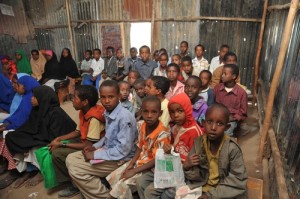![Refugees face a substantially higher risk of psychotic disorders compared to non-refugee migrants [see previous blog].](https://www.nationalelfservice.net/cms/wp-content/uploads/2016/03/6862450441_e83a504169_b-150x150.jpg)
It is estimated that at the end of 2012 there were 10.5 million refugees worldwide. About half of these were under 18 years old (UNHCR, 2013).
It’s consistently found that rates of PTSD and other mental health problems are high amongst refugees (Bogic et al, 2012). The trauma and disruption involved is especially problematic for children because it effects things like schooling and social development that has a disproportionate impact later on (Viner and Ozer, 2012). Unsurprisingly access to mental health services for refugee and asylum seeking children is poor (Reed et al, 2012, Folkes, 2002).
Despite a clear need for mental health services amongst refugee and asylum seeking children, there’s little known about which models and strategies are most effective. Tyrer and Fazel at the University of Oxford set out to review relevant interventions that had been evaluated in schools, community and in refugee camps.
Methods
A comprehensive search of electronic databases and contact with experts combined with strict inclusion criteria allowed them to whittle down 21 studies from 1,716. These 21 studies included a total of about 1,800 children.
The quality assessment using the Yates scale showed some variation: 4 fulfilled the quality criteria, 10 partially so and 7 didn’t fulfil it. For example, only 6 of the studies had data on rates of retention, and minimising of biases was only reported in 18 of the studies. The quality of the interventions varied as well: fulfilled (7 studies); partially fulfilled (8); not fulfilled (6).
The authors are frank about this variation in quality and it also makes clear why a meta analysis wasn’t possible. In many ways, the landscape of publications reflects the diversity of the population and contexts being considered.
Results
The variation amongst the studies is a finding in itself. Here’s a more detailed breakdown:
- Two broad classes of interventions:
- 9 based on verbal processing of past experiences (e.g. CBT, EMDR)
- 7 based on creative art techniques (e.g. music, drawing, drama)
- Also, 5 studies used a combination of both.
- Study designs included:
- 8 with random allocation to groups
- 8 cohort designs
- 4 controlled clinical trials
- 1 case control trial.
- Interventions were delivered in:
- Schools (11 studies)
- Refugee camps (7)
- Community (3)
- Refugee camp schools (2)
- Four of these involved consulting professionals in other services to better cater for mental health problems.
- Numbers of study participants ranged from 6 to 315.
- Recruitment strategies differed across studies. For example, in 5 studies whole classes received the intervention whereas in another 6 studies, children were selected based on meeting specific criteria.
- Most interventions lasted 10-12 weeks with a range of 2 to 16 weeks. The number of individual sessions varied between 6 and 17 with most lasting one hour.
Having found that there’s a mix of studies out there, what about the actual effectiveness of these studies?
- Both verbal processing and creative-art based therapies led to significant reductions in symptoms of depression, anxiety, PTSD, functional impairment and peer problems.
- All but one of the studies set in camps showed significant findings. This means that therapy is effective even when children are in temporary settlements.
- Both group and individual therapies were effective as were short and long-term interventions. This suggests there’s flexibility and opportunities for cost-effective ways of delivering interventions.
- There are some contradictions when looking across studies. For example one study found interpersonal psychotherapy (IPT) effective over activity-based interventions on depression and that the latter was no more effective than waiting list controls. However, another study found creative-art techniques significantly reduced depression. This means one study suggests only verbal-processing based therapies are effective whilst another found that activity based therapies are actually worth pursuing.
Seven of the studies reported enough data for the authors to calculate effect sizes using Cohen’s d. This showed:
- Effect sizes ranging from 0.31 to 0.93 (Cohen said 0.2 is small, 0.5 is moderate, 0.8 is large). Six of the seven studies had effect sizes in the moderate to large range.
- The moderate to large effects related to changes in symptoms like: depression; anxiety; PTSD; functional impairments, peer problems, resource hardship and well-being.
- Five of the seven studies involved were based on those using verbal processing of past experiences (like CBT and EMDR).
Although the authors tried to make comparisons across the studies using Cohen’s effect size, the result doesn’t convince me of the superiority of one type of treatment over another. The variation in studies also makes it hard to compare interventions against each other. To find out more about the problem of comparing psychotherapies, try reading Sammy Man’s blog from January 2014.

Comparing apples, oranges and pears. Most of the studies showed good results but it’s hard to make meaningful comparisons.
Conclusions
In study abstract reports that:
Only a small number of studies fulfilled inclusion criteria and the majority of these were in the school setting. The findings suggest that interventions delivered within the school setting can be successful in helping children overcome difficulties associated with forced migration.
Summary
I felt that the authors made pretty fair conclusions about their findings. As we can see, there’s only 21 relevant but wildly different studies. This is all we’ve got to draw conclusions about what will be effective for millions of wildly different children. I think the review is a decent descriptive account of the mix of studies currently published, but sadly it doesn’t allow us to reliably draw conclusions about what works and what doesn’t.
I like to think I work with a diverse range of people, but really all these people are supported by a homogenous and fairly stable political system (even one that’s a tad unfair…). It’s therefore easy for me to take comfort in the validity of NICE guidelines for those I work with. However, in a context as diverse, dynamic and unpredictable as political unrest and epidemics, perhaps interventions become meaningless when taken away from the individual context in which they were devised.

Can models and strategies for interventions meaningfully be applied across diverse settings and populations?
Links
Tyrer, R., & Fazel, M. (2014). School and Community-Based Interventions for Refugee and Asylum Seeking Children: A Systematic Review. PLoS ONE 9(5): e97977.
UNHCR. (2013) Global trends 2012. Geneva: UNHCR.
Bogic M, Ajdukovic D, Bremner S, Franciskovic T, Galeazzi MG, et al. (2012). Factors associated with mental disorders in long-settled war refugees: refugees from the former Yugoslavia in Germany, Italy and the UK. British Journal of Psychiatry 200: 216–223.
Viner RM, Ozer EM, Denny S, Marmot M, Resnick M, et al. (2012). Adolescence and the social determinants of health. Lancet 379: 1641–1652.
Reed RV, Fazel M, Jones L, Panter-Brick C, Stein A. (2012) Mental health of displaced and refugee children resettled in low-income and middle-income countries: risk and protective factors. Lancet 379: 250–265.
Folkes CE. (2002). Thought field therapy and trauma recovery. International Journal Emergency Mental Health 4 (22): 99–103.
Man, S. (2014). “Everyone’s a winner, all must have prizes!” but which psychotherapy for depression wins, if any? The Mental Elf, 30 Jan 2014.


Mental health therapy for refugee and asylum seeking children: a small evidence base for a big problem: Lauren… http://t.co/CtbzB2lzeH
RT @Mental_Elf: Mental health therapy for refugee & asylum seeking children: a small evidence base for a big problem http://t.co/rwcUztcNkK
Susanne Hart liked this on Facebook.
Kehksha Azam liked this on Facebook.
Morning @minafazeloxford We’ve blogged about your @PLOSONE SR today. Pls have a read & comment if you have time http://t.co/mAI9THO7OD
@Mental_Elf @PLOSONE This is a good overview of the main points of our paper. Keep up the great work Mental Elf
Today @LaurenceDCP considers an SR of #MentalHealth interventions for #refugee & #asylum seeking #children http://t.co/mAI9THO7OD
The Mental Elf liked this on Facebook.
@Mental_Elf Great blog. I wanted to research PTSD in refugee children for my MSc. Was advised ethics committee wouldn’t pass as a student.
SR: interventions delivered in schools can help children with mental health problems assoc w/ forced migration http://t.co/mAI9THO7OD
@Mental_Elf: Review: Mental health therapy for refugee and asylum seeking children by @LaurenceDCP http://t.co/bvT8rV5f6J #mhpss #trauma
“@in2mh: @Mental_Elf: Rev: Mental health therapy 4 refugee & asylum seeking children by @LaurenceDCP http://t.co/0LBdSkZOXW #mhpss #trauma”
Will Convery liked this on Facebook.
Lucy Riddett liked this on Facebook.
Christina Armstrong-Graham liked this on Facebook.
School & community-based interventions for refugee & asylum seeking children http://t.co/mAI9THO7OD #SR
RT @Mental_Elf: SR: verbal processing & art-based therapies led to reductions in MH symptoms in refugee & asylum seeking children http://t.…
Don’t miss: Mental health therapy for refugee & asylum seeking children – small evidence base for a big problem http://t.co/mAI9THO7OD #EBP
@Mental_Elf gr8 article on extent of #mentalillness among refugee #children. Real need to find better ways 2 help. http://t.co/iDkst7Xwgo
@YoungMindsCEO @Mental_Elf Agreed. However, we cant even look after our own. Beds and other infrastructure has diminished.
@YoungMindsCEO @Mental_Elf Thank you Sarah. We do need to think about the psychological needs of the young people behind political unrest.
Mental health therapy for refugee and asylum seeking children: a small evidence base for a big problem http://t.co/7zWRjXn22s
#mentalhealth therapy for #refugee and asylum seeking #children: a small evidence base for a big problem http://t.co/DQDROKEpJd #PTSD
Would love to see more research on work with asylum seekers and refugees. I work within a asylum seeker and refugee mental health team, and am frequently inspired by the resilience that I see within this population. We have a lot to learn I think, and can’t help but wonder that the more scientific we become in our understanding of mental health, the more we regress it seems … ? Is this possible?!